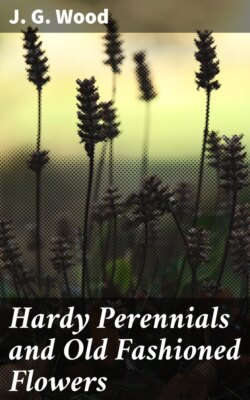Читать книгу Hardy Perennials and Old Fashioned Flowers - J. G. Wood - Страница 3
На сайте Литреса книга снята с продажи.
ОглавлениеPREFACE.
Table of Contents
At the present time there is a growing desire to patronise perennial plants, more especially the many and beautiful varieties known as "old-fashioned flowers." Not only do they deserve to be cultivated on their individual merits, but for other very important reasons; they afford great variety of form, foliage, and flower, and compared with annual and tender plants, they are found to give much less trouble. If a right selection is made and properly planted, the plants may be relied upon to appear with perennial vigour and produce flowers more or less throughout the year. I would not say bouquets may be gathered in the depth of winter, but what will be equally cheering may be had in blow, such as the Bluet, Violet, Primrose, Christmas Rose, Crocus, Hepatica, Squills, Snowdrops, and other less known winter bloomers. It does not seem to be generally understood that warm nooks and corners, under trees or walls, serve to produce in winter flowers which usually appear in spring when otherwise placed.
There are many subjects which, from fine habit and foliage, even when flowerless, claim notice, and they, too, are described.
Many gardens are very small, but these, if properly managed, have their advantages. The smaller the garden the more choice should be the collection, and the more highly should it be cultivated. I shall be glad if anything I say tends in this direction. From my notes of plants useful memoranda may be made, with the object of adding a few of the freest bloomers in each month, thus avoiding the error often committed of growing such subjects as mostly flower at one time, after which the garden has a forlorn appearance. The plants should not be blamed for this; the selection is at fault. No amount of time and care can make a garden what it should be if untidy and weedy plants prevail. On the other hand, the most beautiful species, both as regards foliage and flowers, can be just as easily cultivated.
The object of this small work is to furnish the names and descriptions of really useful and reliable Hardy and Perennial Plants, suitable for all kinds of flower gardens, together with definite cultural hints on each plant.
Perhaps flowers were never cultivated of more diversified kinds than at the present time; and it is a legitimate and not uncommon question to ask, "What do you grow?" Not only have we now the lovers of the distinct and showy, but numerous admirers of such species as need to be closely examined, that their beautiful and interesting features may gladden and stir the mind. The latter class of plants, without doubt, is capable of giving most pleasure; and to meet the growing taste for these, books on flowers must necessarily treat upon the species or varieties in a more detailed manner, in order to get at their peculiarities and requirements. The more we learn about our flowers the more we enjoy them; to simply see bright colours and pretty forms is far from all the pleasure we may reap in our gardens.
If I have not been able to give scientific information, possibly that of a practical kind may be of some use, as for many years, and never more than now, I have enjoyed the cultivation of flowers with my own hands. To be able to grow a plant well is of the highest importance, and the first step towards a full enjoyment of it.
I have had more especially in view the wants of the less experienced Amateur; and as all descriptions and modes of culture are given from specimens successfully grown in my own garden, I hope I may have at least a claim to being practical.
I have largely to thank several correspondents of many years' standing for hints and information incorporated in these pages.
J. WOOD.
Woodville, Kirkstall,
November, 1883.
ERRATA.
Table of Contents
For the placing of capital letters uniformly throughout this Volume to the specific names at the cross-headings, and for the omission of many capitals in the body of the type, the printer is alone responsible.
Numerous oversights fall to my lot, but in many of the descriptions other than strictly proper botanical terms have been employed, where it seemed desirable to use more intelligible ones; as, for instance, the flowers of the Composites have not always been termed "heads," perianths have sometimes been called corollas, and their divisions at times petals, and so on; this is hardly worthy of the times, perhaps, but it was thought that the terms would be more generally understood.
Page 7, line 8. For "lupin" read "Lupine." Page 39, line 31. For "calyx" read "involucre." Page 40, line 27. For "calyx" read "involucre." Page 46, line 1. For "corolla" read "perianth." Page 47, lines 3 and 6. For "corolla" read "perianth." Page 48, last line. For "lupin" read "Lupine." Page 60, line 16. For "pompon" read "pompone." Page 64, line 36. For "corolla" read "perianth." Page 102, line 27. For "Fritillaries" read "Fritillarias." Page 114, cross-heading. For "Ice-cold Gentian" read "Ice-cold Loving Gentian." Page 213, For "Tirolensis" read "Tyrolensis." Page 214, cross-heading. For "Cashmerianum" read "Cashmeriana." Page 215, cross-heading. For "Cashmerianum" read "Cashmeriana." Page 275, line 26. For "corolla" read "perianth." Page 284, line 25. For "calyx" read "involucre." Page 285, line 1. For "calyx" read "involucre."
JOHN WOOD.
November 14th, 1883.
HARDY PERENNIALS
Table of Contents
AND
OLD-FASHIONED GARDEN FLOWERS.
Table of Contents
